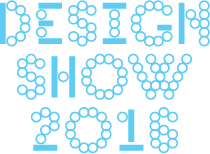DESIGN SHOW 2016: Curatorial Statement
It’s interesting for a curator to choose neither the content nor the title for the exhibition they are curating. It means the curatorial role slips into the role of a choreographer, someone that situates relationships of work as spaces stimulating potential experiences through encounters of material systems. As the curator, I had to wrestle with the desire to name and thereby thematically roof the work in the exhibition. And yet there is no common theme or manifesto shared by the artists in the exhibition, other than their common existence of being graduate students at the same time at the School of the Art Institute of Chicago (SAIC). The very power of the work in DESIGN SHOW 2016 is that it cannot be thematically bracketed. To write a statement which attempted to do so would Cinderella the work into some well-intended but grotesque glass slipper of political, pedagogical or other overarching narrative. To do so would be more Walt Disney’s version of Cinderella, (which is on floor 1 of BLOCK37), rather than Brother’s Grim Cinderella. The blood would be cleaned, cute, safe, ketchup.
And yet this is not the typical student exhibition. DESIGN SHOW 2016 is in the city, not in the space of the school. Which means it meets the messy politics and perception of the different publics in Chicago in a way that is not cradled by the safe perceptual shelter of the institution which connects it.
All artists in their own right, each person in the DESIGN SHOW 2016 does share something in common besides the school that connects them. Each artist probes the world through the materialized imagination. Each in their own way implicitly shows that making and thus designing is a form of knowledge.
One the one hand, each work in DESIGN SHOW 2016 is a mirror to our own perception of what the disciplines of fashion, designed objects, historic preservation, architecture and interior architecture does in the world today. DESIGN SHOW 2016 overlooks State Street. So do most of the departments showing in DESIGN SHOW 2016. The past year State Street has hosted protests from Black Lives Matters to anti Trump and Cruz rallies to walk-outs and protests from public school teachers. Most of the work here was made in spaces overlooking the street. State Street also functions as a space programmed by non-vehicular slow movements, movements asking for difference, for compassion, agency, an empathy and care be reflected in actions, policy, structural changes. While most of this work was made there has been another ecological conference with world leaders regrading ecological crisis in Davos. While working on this DESIGN SHOW 2016 work the past year there has been the ongoing refugee crises of Syrians and Afghanis and others that have gone in and out of our frames of reference, small camps leaving a trail of media mediated feelings often ending in merely being felt. Then forgotten. At the same time there were 31 Governors of US states signing lists to deny Muslim refugees entrance into their states. Illinois is one of those states. In the past 3 months while these works in DESIGN SHOW 2016 have been finding their final forms, there have been 1,135 shootings in Chicago. So how does design matter today? How is what we do in these modes of making making meaningful difference in the world today? How is design changing simply what we have in our lives? There is a need to believe that these things matter. They do matter to the artists in this exhibition. They matter to the people that made this exhibition possible. The administrators and teams behind the scene.
It helps that the work here stems from the artists themselves, rather than starting from the instructors. In other words the work here comes out of the artists own passions, commitments, and lives. But does this feeling and desire forge enough thrust for more critical trajectories in contact with the world? Here, materials and ideas are annealed by imaginations crystalizing what is meaningful to each artist in their own individual language – their own practice of working with and through materials, technology, politics, gender and cultural systems today. The works that you experience here emerge out of the heart of what is important to each person making it. This does necessarily not make it good work. At a larger institutional scale, it does function as an indicator of what is being researched and investigated in a top ranked graduate institution, a complex system of education at a cost of $44,910 a year (fees and residence not included). And each design here is indeed a system whether consciously making it explicit or not. Each design implicitly entangles a geopolitics of reconstituted earth, techne, skill, craft, tradition, learning, experiment, labor and law. Each design is an experience as diverse as the artist that attempts to know and affect the world through their design. Each design is a relationship of care cared for in dialogue with SAIC instructors spanning anywhere from 1-3 years. Each design shows the investment of a life of making as a form of knowledge co-production.
Take one example from DESIGN SHOW 2016, like the work The Urban Orchard, by Allison Rose Crowley. Cutting a vector through all the demographics of Chicago, a series of planters and benches line State St. This designed armature in public space are graves for bodies lined with cinnamon. The cinnamon is used to negotiate the public odors of public decomposition. The bodies are loved one as well as the hundreds of unclaimed bodies found in Chicago each year. Out of the bodies birch tree grow. Public burials are something you lean against while waiting for the bus with strangers. There is always a ceremony happening. A street space at foot level designed primarily for consumption, becomes a place of public reflection, participation, ritual. Someone you love slowly nourishes a space in the city shared by something that blooms and fruits. A different public rhythm of life punctuates your daily path. Daily routines turn into more empathetic rituals. Public spaces are infused with something sacred. Would you be more conscious of your particular time being alive if dying were not something spatially marginalized and emotionally private?
DESIGN SHOW 2016 does swerve past the individual into curated clusters of artists working in the collective realm. One example is an installation by the student initiated collective MoFo. In DESIGN SHOW 2016, MoFo works with the legacy of the African American designer, and SAIC alumni, Charles Harrison. One of Harrison’s early designs was a garbage can. The garbage can often goes unnoted in our lives. If we do take the time to be conscious of waste, it is usually the garbage in each other’s lives that we pay attention to rather than the intensive systems that contain our lives from the individual to populations linked across cities, from kitchen to landfill.
It’s sometimes hard to notice the container in relation to the contained. We usually only see what we are looking for. Disciplinary categories often force the uncanny into the known container. We usually take the container for granted. How much do you question your garbage can, your garment, the physical space in the world where your cloud images are stored, how your emotional heath is linked to your cell phone? Do you question the designs in your own life? Every inch of the city is designed, especially the parts allowed to self-organize. From smart phones to sidewalk planters, design entangles and endorses geopolitical systems all over the world. The works in DESIGN SHOW 2016 each asks us to become conscious of the presumptions and biases we carry with us when we encounter and try to contain design in the world today. How can design connect us more consciously with the processes and powers organizing the world? What containers do you support without being conscious of them? How do you materialize your own questions and imagination in a way that redesigns a small part of your world? What do your designs show?
*Special thanks to Emily Owen, curatorial assistant for DESIGN SHOW 2016.
Curator Eric Ellingsen is the 2015-2016 Mitchell Visiting Professor in Interior Architecture at the School of the Art Institute of Chicago.


